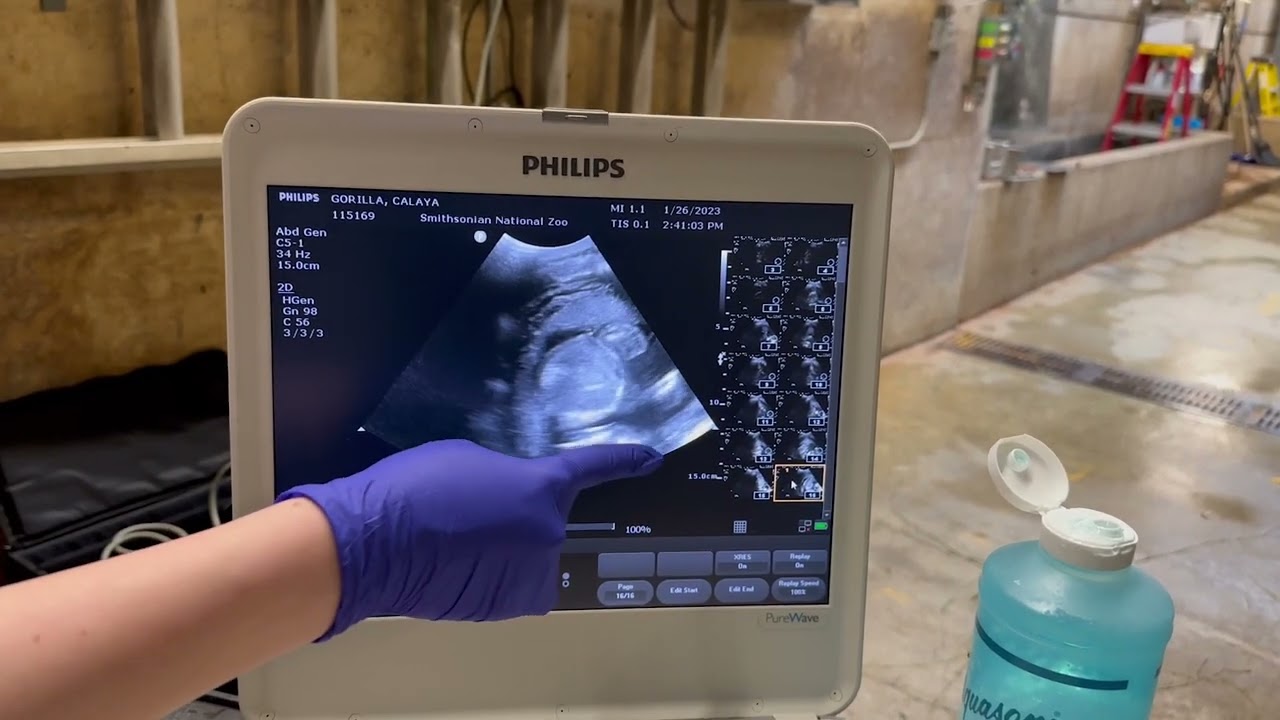*****
Summary of Transcript:
The speaker in the video is conducting an ultrasound of a baby, communicating the image of the fetus on the screen. The baby has a normal amount of gas in the stomach and is surrounded by appropriate fluid. The ultrasound shows the baby’s hands, fingers, a belly, a front arm, a back leg, and a tucked-up head. Overall, the baby appears healthy and complete.
*****
Summary of Description:
The Smithsonian’s National Zoo and Conservation Biology Institute in Washington, D.C. is preparing for the birth of a critically endangered western lowland gorilla, with breeding preparation from the Association of Zoos and Aquariums’ Species Survival Plan. The pregnant 20-year-old female, Calaya, was confirmed through human pregnancy tests, and the primate team is cautiously optimistic that she will deliver a healthy baby between late May and early July. This is the second offspring of the parents, who bred in September 2022. The Zoo will provide updates on its gorilla troop through social media using the hashtag #GorillaStory.
*****
Primate Staff Prepare for Birth of Critically Endangered Western Lowland Gorilla
The primate staff at the Smithsonian’s National Zoo and Conservation Biology Institute (NZCBI) in Washington, D.C., are excitedly preparing for the arrival of a potentially healthy baby western lowland gorilla. The parents-to-be, 20-year-old female Calaya and 30-year-old male silverback Baraka, received a breeding recommendation from the Association of Zoos and Aquariums’ Species Survival Plan (SSP) and bred in September 2022. This is the second offspring for both parents, with their first-born male named Moke.
Pregnancy Confirmation and Monitoring
Animal care staff used a common human pregnancy test to confirm that Calaya had successfully conceived. Because the team trained Calaya to participate voluntarily in ultrasounds, they have been able to monitor fetal growth and development throughout the pregnancy. However, just like with any animal pregnancy, there is a possibility that miscarriage, stillbirth, or complications could occur. For this reason, the primate team is cautiously optimistic about the upcoming birth.
Updates and Expectations
The Zoo will provide updates on its gorilla troop with its Facebook, Twitter, and Instagram channels using the hashtag #GorillaStory. The primate team is hoping that Calaya will give birth between late May and early July. Although they are optimistic, they are realistic about the possibilities of complications or risks. The team’s ultimate goal is to provide excellent care for both the mother and infant while allowing natural behaviors to flourish.
Conservation Efforts for Western Lowland Gorillas
The western lowland gorillas are a critically endangered species that face extinction due to a combination of habitat loss, hunting, and disease. They live in central and West Africa’s dense forests and can be found in several countries, including Cameroon, Gabon, the Republic of Congo, and the Democratic Republic of Congo. According to the International Union for Conservation of Nature (IUCN), their population has decreased by more than 80% over the past three generations. As a result, zoos and other organizations have partnered to raise awareness of conservation efforts and support protection measures.
Smithsonian’s National Zoo and Conservation Biology Institute’s Conservation Efforts
The Smithsonian’s National Zoo and Conservation Biology Institute’s primate team is working in collaboration with several other organizations to protect these magnificent creatures. Through SSPs, reproductive science, and recovery programs, they have committed to saving species from extinction. Furthermore, the Zoo is dedicated to promoting conservation issues to visitors through its exhibits, programs, and outreach efforts.
Conclusion
The birth of a healthy western lowland gorilla would be a significant achievement for the primate team at the Smithsonian’s National Zoo and Conservation Biology Institute. As Calaya’s due date approaches, the team is cautiously optimistic and prepared for any potential risks. Their ultimate goal is to provide excellent care for both the mother and the infant while allowing natural behaviors to flourish. With ongoing conservation efforts, zoos like NZCBI can continue protecting and preserving endangered species like western lowland gorillas.
*****
See Original Source
Source Description
Primate staff at the Smithsonian’s National Zoo and Conservation Biology Institute (NZCBI) in Washington, D.C., are making preparations for the highly anticipated birth of a critically endangered western lowland gorilla. With a breeding recommendation from the Association of Zoos and Aquariums’ Species Survival Plan (SSP), the parents to be—20-year-old female Calaya and 30-year-old male silverback Baraka—bred in September 2022. This is the second offspring for both parents. Their first—a male named Moke [Mo-KEY]—was born April 15, 2018. The primate team is cautiously optimistic that she will deliver a healthy baby between late May and early July.
Animal care staff used a common human pregnancy test to confirm that Calaya had successfully conceived. Because the team trained Calaya to participate voluntarily in ultrasounds, they have been able to monitor fetal growth and development throughout the pregnancy. However, just as with any animal pregnancy, there is a possibility that miscarriage, stillbirth or a complication could occur. The Zoo will provide updates on its gorilla troop through its Facebook, Twitter and Instagram channels using the hashtag #GorillaStory.
LEARN MORE: https://nationalzoo.si.edu/news/western-lowland-gorilla-pregnant-smithsonians-national-zoo-and-conservation-biology-institute.

